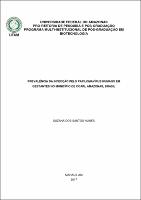| ???jsp.display-item.social.title??? |


|
Please use this identifier to cite or link to this item:
https://tede.ufam.edu.br/handle/tede/6660Full metadata record
| DC Field | Value | Language |
|---|---|---|
| dc.creator | Nunes, Suzana dos Santos | - |
| dc.creator.Lattes | http://lattes.cnpq.br/7481781495100887 | por |
| dc.contributor.advisor1 | Santos, Cristina Maria Borborema dos | - |
| dc.contributor.advisor1Lattes | http://lattes.cnpq.br/7512612117477966 | por |
| dc.contributor.advisor-co1 | Rocha, Danielle Albuquerque Pires | - |
| dc.date.issued | 2017-12-07 | - |
| dc.identifier.citation | NUNES, Suzana dos Santos. Prevalência da infecção pelo papilomavírus humano em gestantes no município de Coari, Amazonas, Brasil. 2017. 85 f. Dissertação (Mestrado em Biotecnologia) - Universidade Federal do Amazonas, Manaus, 2017. | por |
| dc.identifier.uri | https://tede.ufam.edu.br/handle/tede/6660 | - |
| dc.description.resumo | Durante a gravidez, as gestantes sofrem profundas e contínuas alterações anatômicas e fisiológicas para que possam lidar com o aumento das exigências físicas e metabólicas necessárias para permitir o desenvolvimento do feto e as demandas do parto. Estas alterações deixam a gestante mais suscetível às infecções, tais como a infecção pelo Papilomavírus Humano (HPV), podendo trazer consequências tanto para mãe quanto para o seu concepto. O objetivo desta pesquisa foi avaliar a prevalência da infecção pelo HPV em gestantes e verificar a concordância da detecção do HPV entre amostras de urina e cérvico-vaginal. Grávidas no segundo trimestre de gestação em acompanhamento pré-natal nas Unidades Básicas de Saúde (UBS) do município de Coari foram convidadas a participar desta pesquisa, tendo sido colhidas amostras cérvico-vaginal e urinária. A detecção molecular do HPV foi feita através de Reação em Cadeia da Polimerase (PCR) utilizando-se o conjunto de iniciadores PGMY09/11. Os resultados obtidos mostraram que 24,6% (27/110) das gestantes estavam infectadas pelo HPV. Em relação a cada tipo de amostra, foi encontrado HPV em 13 (11,8%) amostras de urina e em 26 (23,6%) amostras cérvico-vaginais. Houve uma concordância observada de 86,4% (IC de 95%, 78,7% - 91,6%) e índice de concordância moderado entre as amostras biológicas (kappa = 0,543, IC de 95%, 0,372 - 0,715). Foi encontrada associação estatisticamente significativa entre a infecção pelo HPV e as variáveis: idade das gestantes (p= 0,014), primigestação (p= 0,027) e nuliparidade (p= 0,046). Portanto, a prevalência do HPV encontrada em nosso estudo, reforça a necessidade de se obter mais informações sobre a infecção pelo HPV na fase gestacional da mulher, tendo em vista as complicações causadas pelo HPV na gestação, como os condilomas gigantes na mãe e a papilomatose respitarória recorrente no concepto. | por |
| dc.description.abstract | During pregnancy, pregnant women undergo deep and continuous anatomical and physiological changes so that they can cope with the increased physical and metabolic demands necessary to allow the development of the fetus and the demands of childbirth. These changes make the pregnant woman more susceptible to infections, such as Human Papillomavirus (HPV) infection, which may have consequences for both mother and her baby. The objective of this study was to evaluate the prevalence of HPV infection in pregnant women and to verify the agreement of HPV detection between urine and cervicovaginal samples. For this, pregnant women in the second trimester of gestation under prenatal care at the Basic Health Units (UBS) of the municipality of Coari were invited to participate in this study, having collected cervico-vaginal and urinary samples. Molecular detection of HPV was done through Polymerase Chain Reaction (PCR) using the primer set PGMY09/11. The results showed that 24.6% (27/110) of the pregnant women were infected by HPV. For each type of sample, HPV was found in 13 (11.8%) urine samples and 26 (23.6%) cervicovaginal samples. There was an observed agreement of 86.4% (95% CI, 78.7% - 91.6%) and moderate concordance index among biological samples (kappa = 0.543, 95% CI, 0.372-0.715). A statistically significant association was found between HPV infection and the variables: age of the pregnant women (p = 0.014), primigestation (p = 0.027) and nulliparity (p = 0.046). Therefore, the prevalence of HPV found in our study reinforces the need to obtain more information about HPV infection in the gestational phase of the woman, in view of the complications caused by HPV during pregnancy, such as giant condylomata in the mother and papillomatosis in the baby. | eng |
| dc.format | application/pdf | * |
| dc.thumbnail.url | https://tede.ufam.edu.br//retrieve/24451/Disserta%c3%a7%c3%a3o_Suzana%20Nunes%20PPGBIOTEC.jpg | * |
| dc.language | por | por |
| dc.publisher | Universidade Federal do Amazonas | por |
| dc.publisher.department | Instituto de Ciências Biológicas | por |
| dc.publisher.country | Brasil | por |
| dc.publisher.initials | UFAM | por |
| dc.publisher.program | Programa de Pós-Graduação em Biotecnologia | por |
| dc.rights | Acesso Aberto | por |
| dc.rights.uri | http://creativecommons.org/licenses/by-nc-nd/4.0/ | - |
| dc.subject | Amostra cérvico-vaginal | por |
| dc.subject | Gestação | por |
| dc.subject | Papilomavírus Humano (HPV) | por |
| dc.subject | Reação em cadeia da polimerase | por |
| dc.subject | Amostra de urina | por |
| dc.subject.cnpq | CIÊNCIAS BIOLÓGICAS | por |
| dc.title | Prevalência da infecção pelo papilomavírus humano em gestantes no município de Coari, Amazonas, Brasil | por |
| dc.type | Dissertação | por |
| Appears in Collections: | Mestrado em Biotecnologia | |
Files in This Item:
| File | Description | Size | Format | |
|---|---|---|---|---|
| Dissertação_Suzana Nunes PPGBIOTEC | 3.02 MB | Adobe PDF |  Download/Open Preview |
This item is licensed under a Creative Commons License





